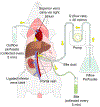Application of Pharmacokinetic Modeling to Characterize Hepatobiliary Disposition of Imaging Agents and Alterations due to Liver Injury in Isolated Perfused Rat Livers
- PMID: 37349653
- PMCID: PMC10739561
- DOI: 10.1007/s11095-023-03549-2
Application of Pharmacokinetic Modeling to Characterize Hepatobiliary Disposition of Imaging Agents and Alterations due to Liver Injury in Isolated Perfused Rat Livers
Abstract
Background: Understanding the impact of altered hepatic uptake and/or efflux on the hepatobiliary disposition of the imaging agents [99mTc]Mebrofenin (MEB) and [153Gd]Gadobenate dimeglumine (BOPTA) is important for proper estimation of liver function.
Methods: A multi-compartmental pharmacokinetic (PK) model describing MEB and BOPTA disposition in isolated perfused rat livers (IPRLs) was developed. The PK model was simultaneously fit to MEB and BOPTA concentration-time data in the extracellular space, hepatocytes, bile canaliculi, and sinusoidal efflux in livers from healthy rats, and to BOPTA concentration-time data in rats pretreated with monocrotaline (MCT).
Results: The model adequately described MEB and BOPTA disposition in each compartment. The hepatocyte uptake clearance was much higher for MEB (55.3 mL/min) than BOPTA (6.67 mL/min), whereas the sinusoidal efflux clearance for MEB (0.000831 mL/min) was lower than BOPTA (0.0127 mL/min). The clearance from hepatocytes to bile (CLbc) for MEB (0.658 mL/min) was similar to BOPTA (0.642 mL/min) in healthy rat livers. The BOPTA CLbc was reduced in livers from MCT-pretreated rats (0.496 mL/min), while the sinusoidal efflux clearance was increased (0.0644 mL/min).
Conclusion: A PK model developed to characterize MEB and BOPTA disposition in IPRLs was used to quantify changes in the hepatobiliary disposition of BOPTA caused by MCT pretreatment of rats to induce liver toxicity. This PK model could be applied to simulate changes in the hepatobiliary disposition of these imaging agents in rats in response to altered hepatocyte uptake or efflux associated with disease, toxicity, or drug-drug interactions.
Keywords: hepatobiliary imaging; isolated perfused rat liver; pharmacokinetics; transporters.
© 2023. The Author(s), under exclusive licence to Springer Science+Business Media, LLC, part of Springer Nature.
Conflict of interest statement
Conflict of interest statement
All authors declare that they have no conflicts of interest to disclose.
Figures






References
-
- Pastor CM, Mullhaupt B, Stieger B. The role of organic anion transporters in diagnosing liver diseases by magnetic resonance imaging. Drug Metab Dispos. 2014; 42:675–684. - PubMed
-
- Kusuhara H Imaging in the study of membrane transporters. Clin Pharmacol Ther. 2013; 94:33–36. - PubMed
-
- Hoekstra LT, de Graaf W, Nibourg GA, Heger M, Bennink RJ, Stieger B et al. Physiological and biochemical basis of clinical liver function tests. Ann Surg. 2013; 257:27–36. - PubMed
MeSH terms
Substances
Grants and funding
LinkOut - more resources
Full Text Sources

